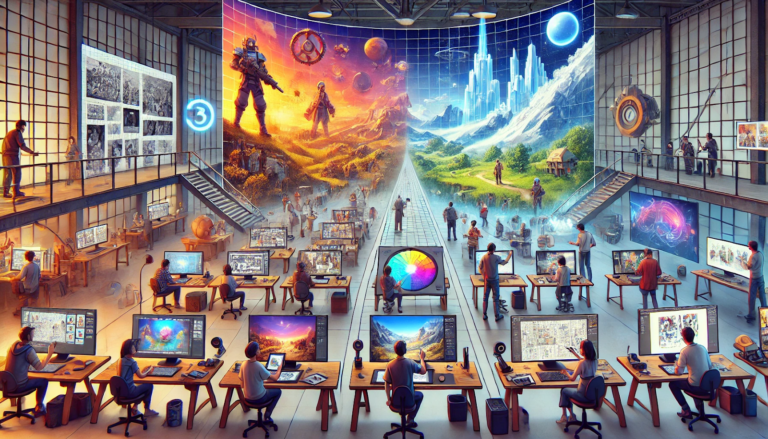The gaming industry has come a long way since its inception, evolving from pixelated graphics to hyper-realistic virtual worlds. Central to this transformation is the role of art studios specializing in 2D and 3D design. Both 2D art studios and 3D art studios have played pivotal roles in defining the aesthetics and overall experience of modern gaming. Let’s dive into how these studios contribute to the evolution of game design and shape the gaming experiences we cherish today.
The Foundations of Game Art: 2D Design
The early days of video games were dominated by 2D art. Classic titles like Pac-Man, The Legend of Zelda, and Sonic the Hedgehog relied on pixel art and hand-drawn graphics to create immersive experiences within the technical limitations of their time. 2D art studios were at the forefront of this era, focusing on:
- Character Design: Creating memorable protagonists like Mario and Mega Man.
- Environments: Crafting visually appealing and easy-to-navigate landscapes.
- Animations: Using limited frames to deliver dynamic motion and action.
Even today, 2D games hold a unique charm. Titles like Hollow Knight and Celeste showcase the timeless appeal of 2D art, demonstrating that it’s not just a relic of the past but a vibrant and enduring style.
The Rise of 3D Art in Gaming
The 1990s marked a significant shift with the introduction of 3D graphics. Games like Doom, Final Fantasy VII, and Super Mario 64 revolutionized how players interacted with virtual environments. The advent of 3D required a new skill set, and 3D art studios emerged as key players in game development.
These studios focus on:
- Modeling: Building detailed characters, vehicles, and objects.
- Texturing: Adding depth and realism to 3D models.
- Animation and Rigging: Creating lifelike movements and expressions.
Modern 3D games, such as The Last of Us Part II and Cyberpunk 2077, showcase the incredible advancements in 3D art. These titles demonstrate how 3D art studios push the boundaries of realism and immersion.
The Role of Hybrid Game Design
Today, the line between 2D and 3D is increasingly blurred. Many games combine elements of both to create unique experiences:
- 2.5D Games: Titles like Octopath Traveler and Trine use 2D gameplay mechanics with 3D visuals, blending the best of both worlds.
- Stylized 3D: Games such as Fortnite and Overwatch use exaggerated, cartoon-like 3D art, reminiscent of 2D animation.
This hybrid approach allows developers to leverage the strengths of both 2D art studios and 3D art studios, resulting in games that are both visually stunning and deeply engaging.
How Art Studios Shape Modern Gaming
Art studios play an integral role in shaping the gaming experience by:
1. Defining Visual Identity
The visual style of a game is often its most recognizable feature. Whether it’s the charming simplicity of a 2D platformer or the breathtaking realism of a 3D open world, art studios define the look and feel that captures players’ imaginations.
2. Enhancing Storytelling
In modern games, visuals are a powerful storytelling tool. From the haunting landscapes of Limbo (crafted with 2D art) to the emotionally charged facial animations in Red Dead Redemption 2 (created with 3D art), art studios bring narratives to life.
3. Creating Immersive Worlds
The environments designed by art studios set the stage for gameplay. A well-crafted world—whether it’s the vibrant forests of a 2D RPG or the sprawling cities of a 3D action game—pulls players into the game’s universe.
4. Innovating Through Technology
Art studios continuously adopt new tools and techniques to stay ahead. From motion capture for realistic animations to AI-driven tools for procedural world-building, the fusion of art and technology drives the gaming industry forward.
Challenges and Opportunities
The evolution of game art is not without its challenges. Creating high-quality assets for modern games requires significant resources, and balancing artistic vision with technical constraints can be difficult. However, advancements in software and hardware have opened up exciting opportunities:
- Indie Development: Tools like Unity and Unreal Engine empower smaller teams to create visually stunning games.
- Virtual Reality (VR): Both 2D and 3D art studios are exploring how to design for immersive VR experiences.
- Sustainability: Studios are experimenting with more efficient workflows and eco-friendly practices to reduce their environmental impact.
Conclusion
The evolution of game design owes much to the artistry and innovation of 2D art studios and 3D art studios. Together, they’ve shaped the gaming industry into what it is today, offering players unforgettable experiences that span from nostalgic 2D classics to cutting-edge 3D masterpieces. As technology continues to evolve, these studios will remain at the heart of gaming, driving creativity and pushing boundaries in ways we can only begin to imagine.
